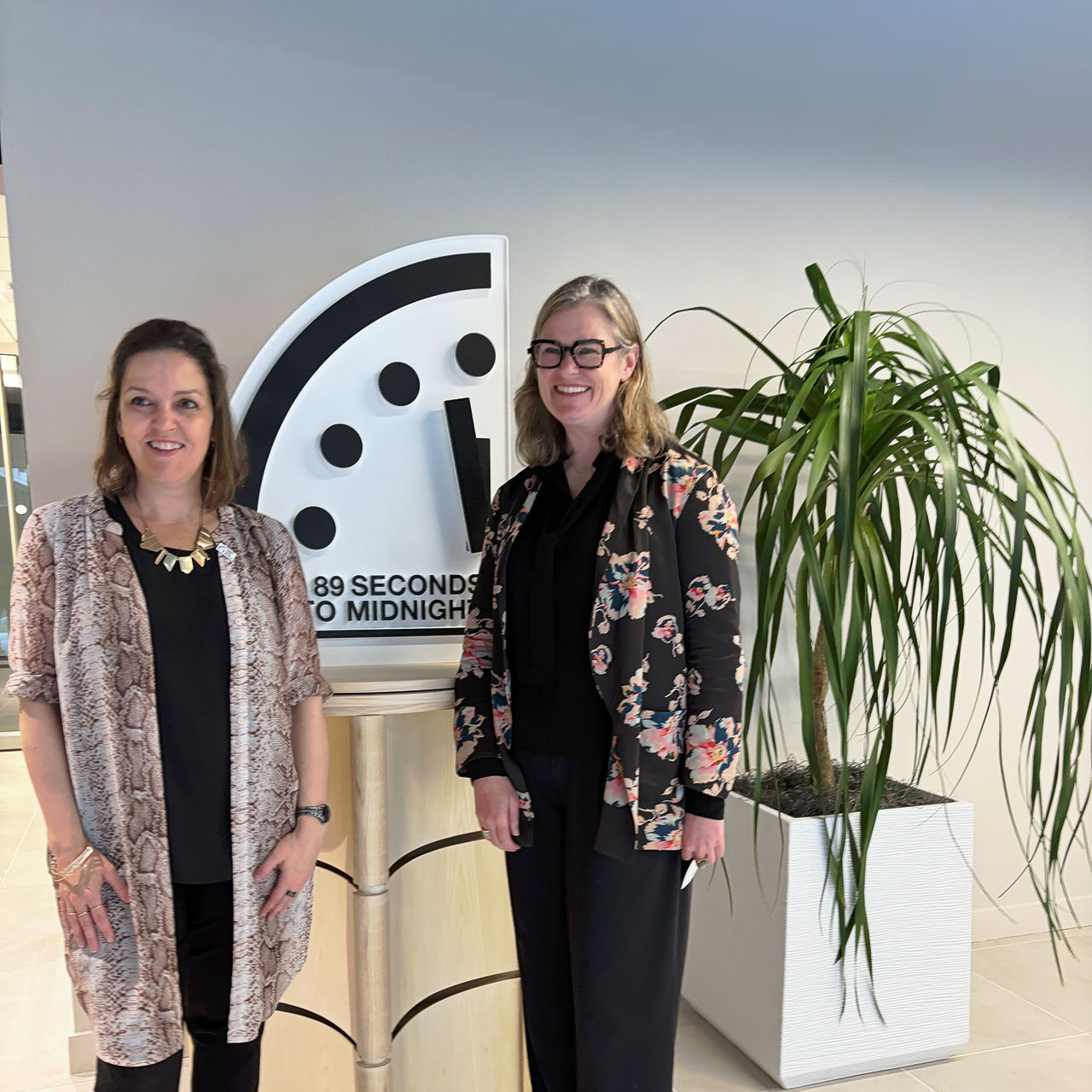Ploughshares Hosts Iconic Doomsday Clock for 2025
This honor is also a reminder of our responsibility to be a backbone for this field, supporting collaboration towards the field’s shared purpose.

May 22, 2025
Last week, Ploughshares and the Bulletin of the Atomic Scientists hosted a reception for a group of grantees and partners at our DC office to celebrate our collective efforts to reduce the threats posed by nuclear weapons. We journeyed from our usual office to the building’s event space, and despite a light smattering of rain, people wove between the food-filled main room and the patio, meeting new friends and connecting with old ones. And in the middle of it all: the Doomsday Clock.
At 89 seconds to midnight, the Clock is the closest it has been to midnight. Through its 78 year history it has been the bellwether to assess our current threat vectors, including climate, biological, and nuclear. Any second, of any minute, of any day, of any week, of any month, of any year, we could face global disaster. This is one of many reasons why the field gathers and celebrates in community on a run-of-the-mill Wednesday evening, recognizing efforts of the past, present, and future.
To many outside of the field, the Doomsday Clock lives in a hypothetical realm—much like the risk of nuclear catastrophe. I started as Ploughshares’ Communications Manager last month, and a fun fact I’ve shared with loved ones is that we (temporarily) host the Doomsday Clock. Their response is usually: “There’s a real Doomsday Clock?”
Alex Bell (pictured top left), President of the Bulletin, emphasized this connection during remarks at the reception:
“It’s part of my job to connect the Doomsday Clock with reading the Bulletin, because that’s where all the expert analysis happens,” she said. “… I want to continue the tradition of the Bulletin being a force multiplier in this community and making this difficult subject matter accessible to people.”
Ploughshares is proud to host the Clock in our DC office throughout 2025. As the largest foundation dedicated solely to reducing the nuclear threat, this honor is a reminder of our responsibility to be a backbone for this field, supporting the collaboration of our shared work towards the field’s shared purpose.
Ploughshares President Dr. Emma Belcher (pictured top right) spoke to this sentiment in her reception remarks:
“As we approach the 80th anniversary of the Trinity Test, of dropping the bomb over Hiroshima and Nagasaki, [this is] a time to remind ourselves of the importance of the work we do, and especially the importance of this community and the strength of it.“
This reception was a time for fostering community against the backdrop of the most notable symbol of nuclear dangers. Here are a few key “fun” facts about the iconic Doomsday Clock and its most recent iteration:
- The Doomsday Clock symbol was originally designed in 1947 by Martyl Langsdorf, who was married to Alexander Langsdorf—a physicist who worked on the Manhattan Project.
- The Bulletin of the Atomic Scientists publishes an official statement on the updated Doomsday Clock every year, as well as deep dives on the four areas now measured to inform the clock: nuclear risk, climate change, biological threats, and disruptive technologies.
- The minute hand on the Doomsday Clock has reset 26 times since its debut in 1947. The most recent reset was this year—2025.
- The Clock was re-designed in 2024 by Tom Weis and Juan Nogueraat of the Rhode Island School of Design, with the intention of carrying “forward the weight of its history while standing as a reflection of the present moment and the technological tools shaping our future.” Read more about their vision and process.
- The Clock typically resides at the University of Chicago and is reset annually in Washington DC. For 2025, Ploughshares will host the Clock in our DC office.
If you are interested in seeing the Doomsday Clock at Ploughshares’ DC office, please contact fieldbuilding@ploughshares.org to inquire about a visit!
